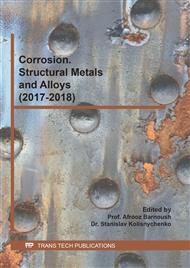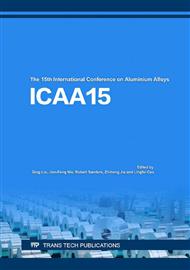[1]
J. Hirsch, Recent development in aluminium for automotive applications, Transactions of Nonferrous Metals Society of China. 24 (2014) 1995–(2002).
DOI: 10.1016/s1003-6326(14)63305-7
Google Scholar
[2]
S. Chen, K. Chen, P. Dong, S. Ye, and L. Huang, Effect of heat treatment on stress corrosion cracking, fracture toughness and strength of 7085 aluminum alloy, Transactions of Nonferrous Metals Society of China. 24 (2014) 2320–2325.
DOI: 10.1016/s1003-6326(14)63351-3
Google Scholar
[3]
W. Gruhl, Stress corrosion crack of high strength aluminium alloys, Zeitschrift für Metallkunde. 75 (1984) 819–826.
DOI: 10.1515/ijmr-1984-751101
Google Scholar
[4]
G. M. Scamans, R. Alani, and P. R. Swann, Pre-exposure embrittlement and stress corrosion failure in AlZnMg Alloys, Corrosion Science, 16 (1976) 443-459.
DOI: 10.1016/0010-938x(76)90065-2
Google Scholar
[5]
K. R. Hebert, Trapping of hydrogen absorbed in aluminum during corrosion, Electrochima Acta. 168 (2015) 199–205.
DOI: 10.1016/j.electacta.2015.03.198
Google Scholar
[6]
D. Najjar, T. Magnin, and T. Warner, Influence of critical surface defects and localized competition between anodic dissolution and hydrogen effects during stress corrosion cracking of a 7050 aluminium alloy, Materials Science and Engineering A. 238 (1997).
DOI: 10.1016/s0921-5093(97)00369-9
Google Scholar
[7]
H. Yamada, M. Tsurudome, N. Miura, K. Horikawa, and N. Ogasawara, Ductility loss of 7075 aluminum alloys affected by interaction of hydrogen, fatigue deformation, and strain rate, Materials Science and Engineering A. 642 (2015) 194–203.
DOI: 10.1016/j.msea.2015.06.084
Google Scholar
[8]
A. S. El-Amoush, An investigation of hydrogen-induced hardening in 7075-T6 aluminum alloy, Journal of Alloys and Compounds. 465 (2008) 497–501.
DOI: 10.1016/j.jallcom.2007.10.126
Google Scholar
[9]
G. A. Young and J. R. Scully, The diffusion and trapping of hydrogen in high purity aluminum, Acta Metallurgica. 18 (1998) 6337–6349.
DOI: 10.1016/s1359-6454(98)00333-4
Google Scholar
[10]
M. Dadfarnia, M. L. Martin, A. Nagao, P. Sofronis, and I. M. Robertson, Modeling hydrogen transport by dislocations, Journal Of Mechanical Physics And Solids. 78 (2015) 511–525.
DOI: 10.1016/j.jmps.2015.03.002
Google Scholar
[11]
G. M. Bond, I. M. Robsertson, and H. K. Birnbaum, The influence of hydrogen on deformation and fracture processes in high-strength aluminum alloys, Acta Metallurgica. 35 (1987) 2289–2296.
DOI: 10.1016/0001-6160(87)90076-9
Google Scholar
[12]
S. P. Lynch, Mechanisms of stress-corrosion cracking and liquid-metal embrittlement in AI-Zn-Mg bicrystals, Journal of Materials Science. 20 (1985) 3329–3338.
DOI: 10.1007/bf00545203
Google Scholar
[13]
T. Magnin, a. Chambreuil, and B. Bayle, The corrosion-enhanced plasticity model for stress corrosion cracking in ductile fcc alloys, Acta Materialia. 44 (1996) 1457–1470.
DOI: 10.1016/1359-6454(95)00301-0
Google Scholar
[14]
N. J. H. Holroyd and G. M. Scamans, Stress corrosion cracking in Al-Zn-Mg-Cu aluminum alloys in saline environments, Metallurgical and Materials Transactions A. 44(2013) 1230–1253.
DOI: 10.1007/s11661-012-1528-3
Google Scholar
[15]
A. Cassell, Durability of lean 7xxx series aluminium alloys, thesis. (2013)1–345.
Google Scholar
[16]
N. Birbilis and R. G. Buchheit, Electrochemical characteristics of intermetallic phases in aluminum alloys, Journal of Electrochemical Society. 152 (2005) B140.
DOI: 10.1149/1.1869984
Google Scholar
[17]
L. Christodoulou and H.M. Flower, Hydrogen embrittlement and trapping in Al-6%-Zn-3%-Mg, Acta Metallurgica. 28 (1980) 481–487.
DOI: 10.1016/0001-6160(80)90138-8
Google Scholar
[18]
C. Larignon, Mécanismes d'endommagement par corrosion et vieillissement microstructural d'éléments de structure d'aéronef en alliage d'aluminium 2024-T351, thesis. (2011).
Google Scholar
[19]
Q. Puydt, Comportement mécanique de soudures en alliage d'aluminium de la série 7xxx : de la microstructure à la modélisation de la rupture, thesis, (2012).
DOI: 10.1016/j.crme.2004.09.006
Google Scholar
[20]
M.B. Kannan and W. Dietzel, Pitting-induced hydrogen embrittlement of magnesium-aluminium alloy, Material Design. 42 (2012) 321–326.
DOI: 10.1016/j.matdes.2012.06.007
Google Scholar



